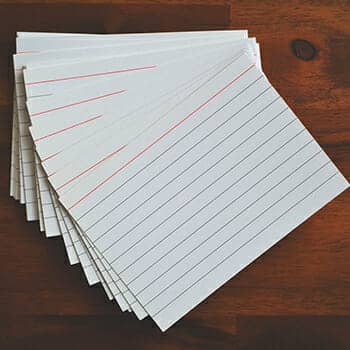 The Leitner System is a powerful variation on flash cards that is sadly not as well known as it could be.
The Leitner System is a powerful variation on flash cards that is sadly not as well known as it could be.
To my knowledge, that’s because Sebastian Leitner’s book has never been translated into English.
But because I read German (partly in thanks to modifying the Leitner method), let me explain everything to you.
That way, you’ll know whether or not his approach to learning is right for you.
Frankly, it’s one of the best ways to get the most out of spaced repetition.
It fuses seamlessly with other learning techniques too, like the Memory Palace.
So if you’re ready for an incredibly fun way to learn faster and remember more, let’s dive in!
What Is the Leitner System?
As you probably know, spaced repetition is a cornerstone of effective learning.
Sebastian Leitner, like many people in the accelerated learning space, wanted to find ways to reduce the amount of repetition required. But without sacrificing comprehension or long-term memory.
Along with many other luminaries of learning, like Barbara Oakley, Tony Buzan and myself, Leitner is passionate about learning faster due to inadequacies in the public education system.
As he says in the opening of his book, So Lernt Man Lernen (That’s How You Learn How To Learn), it was anger that drove him to find a better.
So what is the Leitner System?
It’s basically a means of organizing your Zettelkasten or flashcards in a way that reduces the forgetting curve and optimizes retention.
Although some people think using cards and boxes is old-fashioned, there’s a rising return to these older methods.
Why?
A few reasons that we’ll explore below.
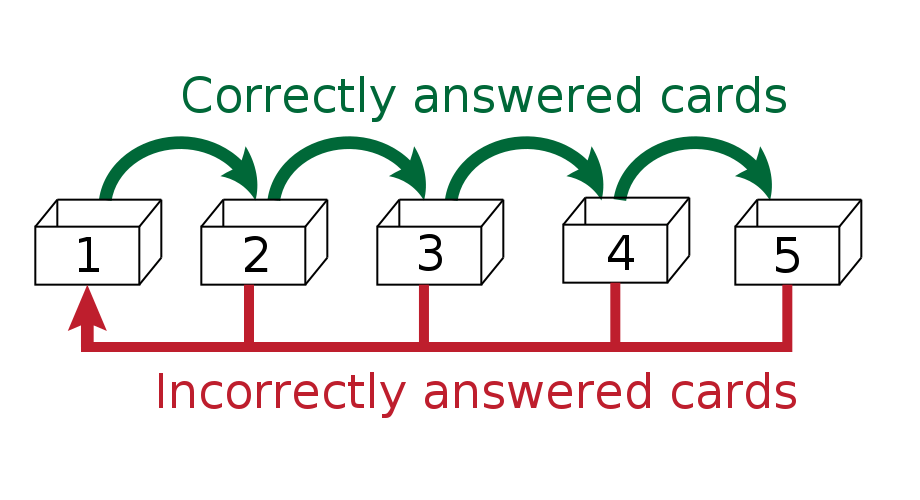
One of the most important points is that the Leitner method provides a form of self-testing that helps you avoid apps like Anki that may be contributing to digital amnesia.
But more than just a mechanism for optimizing spaced repetition, Leitner’s book is about thinking critically.
For example, he calls the idea of Intelligent Quotients “monstrous.” Like myself, he finds the signs of genius in what a person does, not some scientific measurement.
How Does the Leitner Method Improve Your Memory?
There are several ways you can use the Leitner schedule to improve how fast you learn and increase how much you remember.
The first is the scheduling itself, which I’ll talk more about in a minute. But here are a few other ways that it makes sense to use Leitner Boxes.
One: Visible Methods Get Used
People email me all the time asking me to explain how they can remember to use the spaced repetition software they’ve downloaded.
I always suggest the Leitner system to these people because it’s easy to forget what you can’t see. That’s where we get the phrase “out of sight, out of mind,” after all.
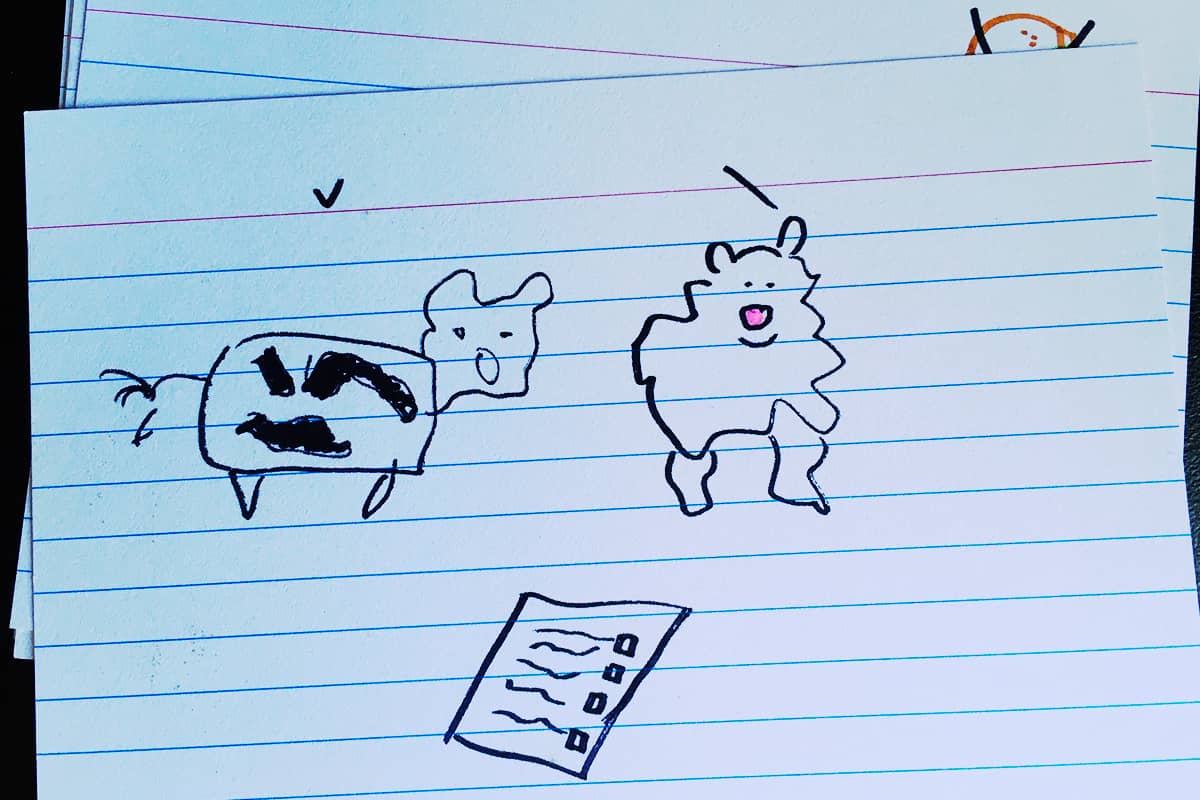
But when you use physical index cards and arrange them in boxes, you’ll see them every day. That makes it impossible to forget to use this learning system.
I’ve explained how The Freedom Journal works in a similar way as a visual reminder.
Sure, you can set reminders on your phone, but they’re easy to dismiss, and even easier to turn off. But physical objects you’ve invested in and keep in your learning environments tend to get used much more often.
Two: The Leitner System Optimizes Spaced Repetition
By actively engaging with the cards and self testing manually, you’re giving yourself the gift of honesty.
Whereas a spaced repetition app “hides” the cards after you tell it how well-you memorized it, the Leitner scheduling method increases the accuracy of your self-assessment because you have to visually place the card in one of the boxes.
Self-testing has been shown to help students ace exams, and Leitner’s approach gives you an easy and fun way to improve your proficiency as a learner on a daily basis.
Here’s an example schedule based on the Leitner System I’ve used recently for learning geometry:
- Day One: 10 new names of shapes (i.e. dodecagram, icosahedron, etc.)
- The shapes are drawn on the faces of the cards, and a mnemonic image on the back to help prompt faster memorization
- Day Two: Testing recall of all 10 names by looking at the shapes on the faces of each card
- Any incorrectly recalled cards go back to day one and correctly recalled cards proceed to day three
- Day Three: Days One and Two are tested at the same time
- Correctly recalled cards advance to Day Four
- Incorrectly recalled cards are moved back to Day One
- Day Four: Days One, Two and Three are tested
- Correctly recalled cards advance to Day Five
- Incorrectly recalled cards are moved back to Day One
- Day Five
- Correctly recalled cards can be either removed from the sequence or put in a longer sequence
- Incorrectly recalled cards are moved back to Day One
It can sometimes be difficult to decide whether a card correctly recalled over all five days is truly memorized. But you can always run each card through the entire sequence again if you have any doubts.
If you’re wondering whether you should use a Leitner Box instead of a spaced repetition app, as this scientific study shows, the software programs are based on the basic rules Leitner applied to index cards and using the boxes.
Ultimately, it’s a personal decision whether you use digital cards and boxes or the “real” thing using pen and paper. As this study discusses, we simply don’t have enough research yet to make any hard and fast claims one way or another. But as the authors of this study suggest, “college students commonly use digital flashcards in a manner that only partially reflects evidence-based learning principles.”
This point is important: no matter what method you use, it’s important to use it thoroughly and completely. Half-efforts are unlikely to give you the full power of any accelerated learning technique.
Three: Interleaving
One of the letter known values of using the Leitner boxes is that you can distribute your cards throughout multiple boxes and study multiple topics at the same time.
For example, let’s say you’re studying biology. You can distribute your review sections throughout one box for that topic.
Then, in another box, you can study chemistry.
As you rotate between the topics, you’re giving yourself the benefits of diffuse thinking and interleaving. These are basically “brain rewiring” learning processes that take place as if on autopilot.
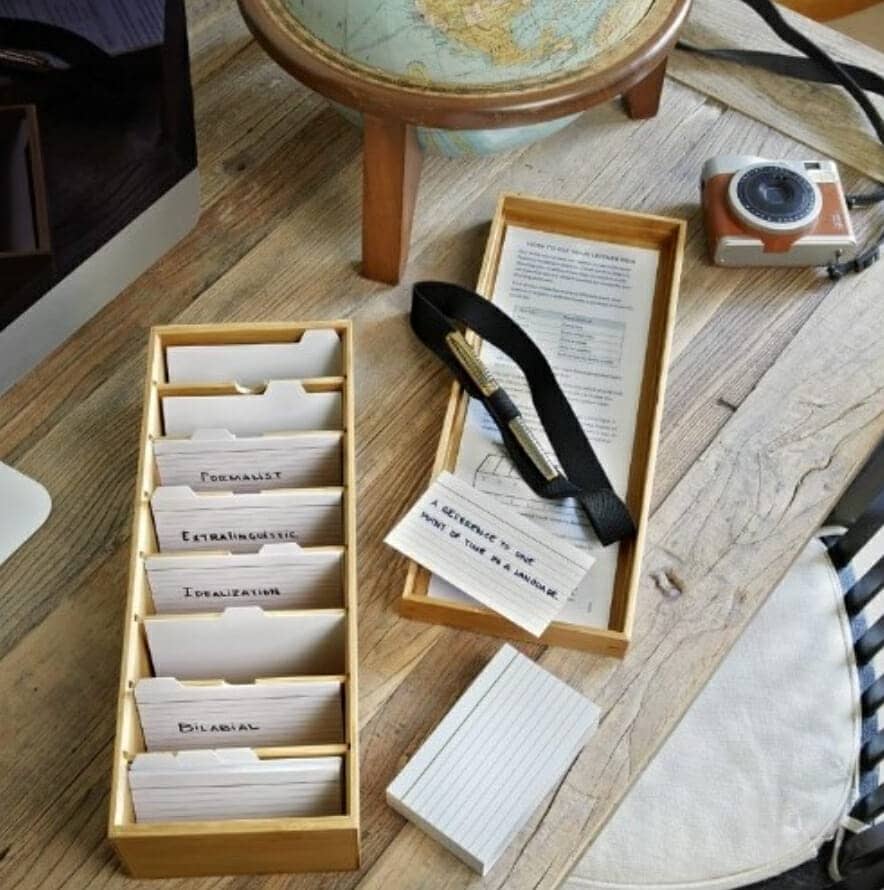
It’s kind of like how water percolates through coffee grounds to produce a delicious drink. But in this case, it’s about giving your brain some time to percolate the knowledge to create wisdom.
How to Use Leitner Flashcards to Memorize Your Study Material
Let’s turn now to some ideas for how to make the most out of using the Leitner system as part of how you learn languages, tackle textbooks or absorb any kind of information.
These are the steps that I follow. I’ve modified them in some ways, but as Leitner himself points out in his book, you’re looking for the smallest hinges that swing the biggest doors.
He uses the term selbstversuch, which means “self-experiment.”
The science of learning is quite clear, but how you apply it is always that: a kind of experiment.
So with that in mind, let’s look at one example process.
Step One: Create Your Cards
Assuming you have worked out your learning goals and optimized them within a learning cycle, creating cards is a sheer pleasure.
The simplest way to do it is with index cards or recipe cards from either the grocery store or a discount shop. Sometimes you can find them even more inexpensively if you buy them in bulk online.
As Tony Buzan suggests in Mind Map Mastery, it’s a best practice to incorporate multiple colors and drawings. I do that a lot with my language learning projects.
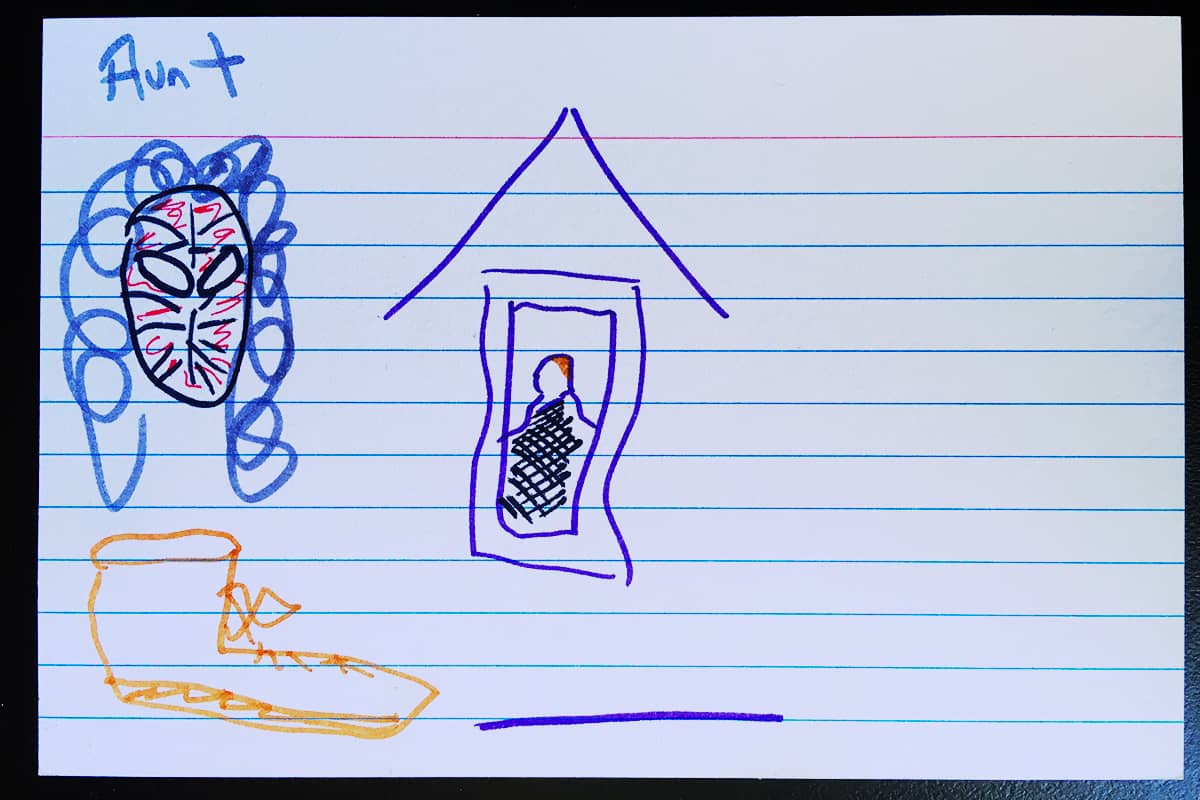
A key trick for language learning is to maximize active recall by creating little puzzles that “force” you to stretch your mind. This is a key difference from what Leitner teaches, which has principles for the front and back of cards.
When learning from books, however, I include information like the page number, book title and always have a card that tells me the name of the publisher and the publication date. Even with this strategy, I try to keep the back of my cards blank.
It can be tricky figuring out exactly what to memorize in books, so that’s why I created this tutorial for you on finding the main points in any learning material.
Step Two: Decide Your Schedule
Exactly how much review you need is highly personal. You’ll have to experiment.
I suggest that you start with the classical Leitner method and use five days. If you need more, you can expand to more by other changing your Leitner box or creating a new one.
Personally, I don’t use anything fancy. I save my shoeboxes and use those.
Some people love to go all out and use wood boxes and that’s cool too. Symbolic luxury can help your brain understand that you’re taking the goal seriously. And because premium boxes are nicer to look at, you might give yourself extra encouragement to keep them even more prominent in your living environment.
Step Three: Self Test In Limited Sets
One of the problems with spaced repetition software is that people overpack them.
This not only creates discouraging amounts of material to review. It’s not effective.
Instead, go through 5-10 cards at a time. If you’re using a Memory Palace in combination with your Leitner boxes, you can try my “magic number” of 10 piece of information per Palace.
(There actually isn’t anything “magic” about the number 10, but I find it helps make Recall Rehearsal much faster and easier. This is a principle taught in the Magnetic Memory Method Masterclass.)
Step Four: Be Radically Honest
You do not help yourself if you don’t accurately assess how often you need to review different pieces of information.
Leitner acknowledges this issue, and basically says that we need to try and “program” ourselves as if we are computers.
This idea isn’t new. Ramon Llull thought something similar when he created his Memory Wheels centuries ago.
No matter what learning method you use, it’s important to not let yourself get frustrated if you make mistakes. Instead, you need to see each mistake as yet another opportunity to learn.
Keeping a memory journal will help, and here are some tips from a memory champion on how to do that.
Step Five: Write Summaries
Frankly, it’s easy to get bored with going through cards over and over again.
To accelerate the learning process, I suggest that you sit down, use reflective thinking and write out what you’ve placed on your cards.
This process gives you another form of self-testing. But it’s more profound because it creates a layer of context and connective webbing that raw repetition never will.
It’s the equivalent of extending your learning of a new word to memorizing an entire sentence in a language.
Will The Leitner System Work For You?
I believe so.
The trick is making sure that you use it for long enough to really enjoy the benefits.
If learning really is like programming in any sense, it’s important to realize that no great software is written overnight.
I don’t fully agree that learning is like programming, though I can see why the analogy works for some people.
Where I can agree with Leitner is on a point highlighted by another learning and memory teacher: Harry Lorayne.
As Lorayne often pointed out, focused attention is where all learning begins and it’s ultimately where it culminates in using what you’ve learned.
To help focus your mind, I highly recommend the Memory Palace technique. Here’s a free course that takes you into it:
Once you have a few Memory Palaces created, you’ll see how you can combine one Memory Palace with one Leitner boxes.
The more Memory Palaces you link with Leitner Boxes, the faster you’ll learn.
I’ve been using this memory hack for nearly three decades now, and it is powerful. I don’t think I would have gotten through university or learned languages without having it in my toolbox.
The best part is that the Leitner technique gives you a structured, hands-on means of taking control of your own learning journey. It’s about being involved, not relegating your goals to a machine.
Because it’s up to you to promote or demote the cards through the various stages of the Leitner boxes, you’re giving yourself a well-balanced and authentic learning experience.
Instead of seeking shortcuts, you’re tending to the garden of your mind.
And that’s a beautiful thing. All the more so in a world where standardized tests aren’t going away and there’s more culture to enjoy than ever.
So long as your memory is sharp.
Related Posts
- The Most Controversial Language Learning Technique In The World
In this episode of the Magnetic Memory Method Podcast ... controversy about using mnemonics in…
- Bilingualism: Why Language Learning Makes For a Healthier Brain
Bilingualism is said to enhance your better problem-solving abilities, and improve your concentration and focus.…
- How to Memorize Pi: A Proven Method
Want to know how to memorize pi? The standard advice might not get you there…








2 Responses
I do not have word’s enough to thank you. Long story short I was not able to memorize the words to a second language I wanted to learn. So I took most of the Udemy’s classes and they did not do a thing. Than in one of my last ditch effort in one of your classes you mentioned the word “Aphantasia”in the context of not seeing your memory palace.
I never hear of that word. I looked it up AND it explained a whole lot about my life long challenges!!! I found out I have Severe Congenital Aphantasia and SDAM. I spent most of my elementary school years in the hallway or writing words on a blackboard because I always failed the spelling and writing tests no matter how hard I or the teachers tried.
I have had to always write things down in a journal or lab-book. My environment is highly organized so I can find things. It has always been this way and nothing has change as I get older. BUT this has not stopped me from being a very successful Software Engineer with only a two year degree. I get the problems know one else can solve but I can easily deeply focus since I don’t have all these images and memories floating around in my head.
Currently I am exploring the Leitner system a second time to see if I can get it to work for me. In the past I used the standard offsets and I was able to remember some words but only with a lot of time spent.
Again a heart felt thank you
David Rogers
Great to hear from you, David, and glad that the topics explored on this blog have helped you figure this out.
The Leitner approach is a great alternative and works well in combination with the conceptual types of mnemonics I tend to use myself. Although I now can see images in my mind, I rarely take or need that step.
Enjoy exploring this approach and rest assured that you can optimize it further by continuing to explore what your memory is and how it works.